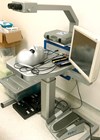You’ve made into ophthalmic specialist training and before you know it, it’s your first on-call shift. You are expected to provide the specialist on-call service out of hours and there is a new wave of responsibility, with, let’s be honest, very little previous exposure at university or foundation training. Medical registrars, general practitioners and emergency departments receive a variety of ophthalmic presentations and as the first ophthalmologist on-call, I was expected to triage these referrals.
I recently experienced my first weekend on-call, where I found myself frustrated and pulled in all directions. It felt like I had been thrown back to holding the medical bleep, but this time I didn’t have the cumulative knowledge from medical school. This was combined with my acute awareness that I’d trained as a doctor for three years already. Surely, I should ‘know my stuff’? Other medical specialties have the perception that ophthalmologists have it easy with our “non-resident on-calls”, however, taking the bleep home after a full day of work takes some getting used to.
My first booked patient arrived for my shift before I had – a lady with a red eye who was seven months pregnant. Already I am asking myself: What drops are safe in pregnancy? Then my phone starts ringing: no caller ID. The first of many to come. I did not feel prepared. Within the next hour I was at the emergency department to see a young man with an eyelid laceration. I had performed suturing in the past, but never an eyelid! Nothing quite prepares you for the excitement of a new specialty, but also the resounding self-doubt as I started to grasp how much I had to learn in the journey ahead of me.
There are the usual ‘pre-on-call’ rituals we all come to adopt so we can be better colleagues. For example, getting seven hours of sleep or having snacks ready. Despite this, as an ST1 I found myself alone for periods of time, trying to juggle incoming referrals, physically see patients and navigating new tools. Despite this, from personal experience and the advice of my helpful senior registrars, I found some small but impactful actions that made subsequent shifts run more smoothly.
Examination routines
During the first few days, I wanted to “get to the point” of any presentation. Ophthalmology needs keen attention to detail, including the relevant negative signs. I trained myself to develop a habit of systematically examining the eyes. When I was stressed or tired, I had a structured routine of making sure I didn’t miss signs that may require further investigation. An example of this was in an eye with trauma, I’d ask myself at each structure: “what would trauma at the level of cornea, iris, or retina present with?”
Your team
Leading up to my first shift, I took the opportunity to shadow colleagues on-call who were ST2 and above. This gave me immense insight into the logistics of the on-call in my local department. Booking patients, arranging pharmacy orders out-of-hours, and accessing microbiology culture plates can be time-consuming, and are worth knowing how to do early.
During normal clinic hours there is often a short period of time while patients are waiting for common investigations such as optical coherence tomography (OCT). I took this opportunity to learn how to perform these scans and learn about effective patient positioning from the experienced technicians. It was incredibly useful, as out-of-hours you’ll be able to independently perform these valuable investigations.
Helpful tools
During the evening I realised referred patients can arrive at quite unpredictable times. I started to keep a running list (in a secure app or notebook) of each call and every accepted referral. It helped quite simply to keep track of who was walking into the service versus those I was expecting from fellow colleagues. However, remember data protection and keep any patient identifiable information secure.
The kit
Invest in your lens early.
There is a lot of debate regarding the best first lens for examining the fundus: 90D, widefield or superfield? Practising using these as often as possible and getting used to examining the fundus is key. If you can buy a lens of your own, you often save time looking for one on-call.
Local guidelines
Find the local eye casualty guidelines and save this as a PDF, alongside the Oxford Handbook of Ophthalmology and The Wills Eye Manual. I try to read about a presentation before I see the patient to help guide my examination.
Helpful apps
There are a lot of new medications in ophthalmology, mainly in drop form. The Liverpool interaction tracker can help identify key interactions with other specialist medications, for example, HIV medications. The app ‘Eye Handbook’ contains helpful plates of common tests from an Ishihara chart you can flick through conveniently on your phone, an AMSLER grid, fixation targets for kids and a calculator to approximate the intraocular pressure in relation to corneal thickness. Currently this is the most used app on my phone during on-calls.
Ultimately, we will all find ways to navigate our on-calls. As with any specialty, fundamentally it is about teamwork, knowing when to ask for help, and to escalate any issues or concerns early with the consultant-on-call. I learnt, not only from experience with patients, but also from the invaluable guidance of senior colleagues, who have been through it all before.
Remember to share your on-call experiences, the good and the bad with your fellow ST1 colleagues. I have learnt so much from them, and sharing can help manage your mental health around what is a steep but rewarding learning curve in one of the best specialties.
COMMENTS ARE WELCOME











